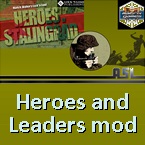asl3d
Posts: 6531
Joined: 2/6/2017
Status: offline

|
The landing craft mechanized (LCM) is a landing craft designed for carrying vehicles. The Landing Craft, Mechanized (LCM) was produced in seven Marks by the US and Great Britain for their amphibious forces during World War Two. The US Navy, Army, and Coast Guard utilized the Marks 2, 3, and 6. The British forces used the Marks 1, 4, 5, and 7.
In 1941, the US Navy requested designs for an enlarged landing craft that could han-dle and land a light tank. They contacted Higgins Industries in New Orleans and requested a larger design than the LCVP. A few days later, several naval officers traveled to New Orleans to examine some designs. They found a working prototype of the LCM-2, a landing craft with a bow ramp and the ability to carry a 16 ton tank. Higgins had built the LCM prototype in just over 60 hours!, which was then tested before high ranking officials of the Marine Corps and Navy on May 30, 1941.
The LCM-3 was designed to carry and land a 30 ton tank (it could transport a middleweight tank, like the M4 Sherman) or motor vehicles on the beach, or 60 soldiers embarked. Compared with its predecessor, the LCM-2, its length was increased by 1.5 meters to 15.2 meters overall, while the beam remained at 14 feet. The forward draft increased by 0.5 meters to 0.9 meters, while the rear draft remained at four feet. The LCM-3 cargo well was 9.4 meters long and 3 meters wide. Its displacement was 23,587.2 KG light and 47,174.4 KG fully loaded. Power was provided by either two 100 HP, Kermath six cylinder gasoline engines or two 225 HP Gray Marine diesels. The diesel-powered LCM-3's speed was rated at 8 knots (9.2 MP/H) fully loaded and its range was 225.3 Km at full speed. Its maximum endurance was 1,367.9 Km at an economical 6 knots (6.9 MP/H). The steering position was protected by 6mm High Tensile Steel (HTS) and some were fitted with plastic armor on the coxswain's position. The LCM-3 was usually armed with two .50 caliber (12.7mm) Browning M2 (HB; Heavy Barrel) machine guns, situated to either side of the steering position. A few LCM-3s were fitted with rocket racks and redesignated as Landing Craft, Mechanized (Rocket), or LCM-R. They were mainly used in the Pacific until the Landing Craft, Infantry (LCI) and Landing Ship, Medium (LSM) were fitted with rocket launching equipment. Various US shipyards built 8631 LCM-3s during the conflict.
At first view, the LCM looks like the LCVP. Distinctive feature on this type was the high bow-ramp. Further more, with its length of 15.20 meter it was much larger then the LCVP. Another difference was the used material, the LCM was almost completely built out of steel plate (with exception with the early ones, which had wooden coxswains shelters for the compasses, so they would not be affected by the steel).
The LCM from Higgins became the LCM Mk 3, also called the 'tanker lighter'. Higgins built also an extended version of the LCM, the LCM 6. When the production ended, some 11,392 LCM’s were built.
At D-Day there were 486 at hand, 78 were lost during the next two days. In all, 486 LCMs were committed to Operation Neptune, including 358 of the LCM-3 version. The total was almost evenly divided between the U.S. and British navies. Additionally, the U.S. Navy counted almost 1,200 LCMs in the Pacific Fleet, while the Allies listed 280 in the Mediterranean.

 Attachment (1) Attachment (1)
_____________________________
Semper fidelis
|
 Printable Version
Printable Version





































 New Messages
New Messages No New Messages
No New Messages Hot Topic w/ New Messages
Hot Topic w/ New Messages Hot Topic w/o New Messages
Hot Topic w/o New Messages Locked w/ New Messages
Locked w/ New Messages Locked w/o New Messages
Locked w/o New Messages Post New Thread
Post New Thread